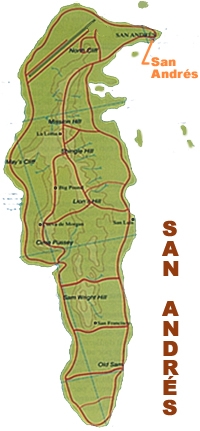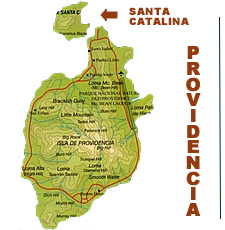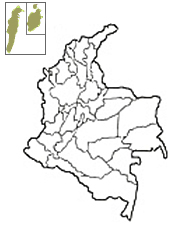 |
 |
|
 |

SAN ANDRES
Inhabitant: Sanandresano
The capital of the
archipelago is an island of 27 square kilometres.
Its most important natural attractions are its
impressive reefs, beaches and crystal clear blue waters where all kinds
of water sports can be enjoyed. Other places worth visiting are The
Hoyo Soplador (blowing hole), Morgan's Cave, Jonny Cay and
Haynes Cay.
Downtown, known locally as Nord End, you
will find government buildings, stores, shopping centres and the main
beach area, called Sprat Bight.
La Loma (The Hill) district, a fine display of traditional architecture,
is found in the centre of the island.
San Andres has an excellent hotel infrastructure and a great variety of
commercial establishments.
It also has a great nightlife, with many places to eat, dance, listen to
Calypso, Reggae and Socca music and sample the rum and coconut
cocktails.
The population of this small paradise is about 65,000 and its economy is
based on commerce and tourism.
The Island was declared a duty-free zone in 1953.
|

|
 
SAN ANDRES, PROVIDENCIA AND SANTA CATALINA
This fascinating archipelago with an extent of 250,000
square kilometres comprises the islands of San Andrés (the main
island), Providence and Santa Catalina, Albuquereque, Serrana,
Bolívar, Roncador y Quitasueño cays, and Alicia and
Serranilla sandbanks, among others.
It is populated by 75,000 people. The archipelago is
located in the Caribbean Sea, 700 kilometres northwest of the Colombian
mainland.
The first settlers were the British, who arrived in these
islands accompanied by some African slaves. Later, they were colonized
by the Spaniards. Under Spanish rule the islands were recaptured by the
English pirates Morgan and Manswelt. In 1793, England recognized Spanish
sovereignty over the archipelago but by 1806 the islands were once again
controlled by the British.
Since 1868 the archipelago has belonged to the Republic
of Colombia.
The Colombian Constitution of 1991 gave the islands
status as a “Colombian Department” along with other Colombian
territories.
Due to their historic and cultural heritage, the Sanandresanos
(natives of the islands) have their own culture different from
the people of mainland Colombia. Almost all of them speak Spanish,
English and a native dialect called patuá.
The island's music has a variety of rhythms: polka,
mazurka, schottische, walts, fox trot, pasillo, calypso and
mentó.
The “Sea of Seven Colors”, the beauty of the white-sand beaches, Old
Providence Natural Park and Haynes Cay Natural Aquarium, attract
thousands of Colombian and international tourists every year.
In 2000, UNESCO officially declared the Archipelago a "Seaflower
Biosphere Reserve".
Capital:
San Andres (Left column)
Providencia
On this island of great beauty, you will find the Old
Providence Natural Park. It is a municipality of the archipelago with an
area of 17 square kilometres.
It is criss-crossed by small rivers that provide fresh water to the
islanders. There are also some small villages.
The tourism industry leads the economy.
Santa Catalina
A volcanic island, tiny Santa Catalina has an area of only one square
kilometre. About 400 people live there.
 |

